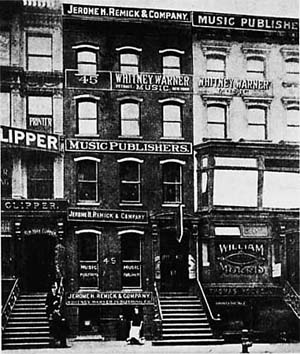
Tin Pan Alley, 1910
After the American Civil War, the demand for sheet music skyrocketed from the result of increased piano sales. Due to this, music publishing became a rapidly growing business with New York becoming its epicenter. In its heyday, Tin Pan Alley had huge commercial success with many songs selling well even by today’s standards (Charles K. Harris’s ‘After The Ball’ (1892) sold over five million copies). It is because of the loose copyright laws that Tin Pan Alley was such a huge success for big companies, and also why copyrights, with attention paid to the rights of artists, became much stricter in later years.
The end of Tin Pan Alley is debated. Some say, it was the Great Depression that killed the business while others blame Rock ‘n’ Roll in the 1950s for putting the final nail in the coffin. Regardless, what stands of Tin Pan Alley today is little more than a plaque on a sidewalk, and not even the correct one in the heart of the district; you’ll have to go one block west, between Sixth and Broadway to take your souvenir photo. What we do have to remember Tin Pan Alley by today though is its legacy of songs, from “Happy Days Are Here Again” (Jack Yellen & Milton Ager, 1930) to “God Bless America” (Irving Berlin, 1918; revised 1938).
 MUSEYON BOOKS Smart City Guides for Travel, History, Art and Film Lovers
MUSEYON BOOKS Smart City Guides for Travel, History, Art and Film Lovers


